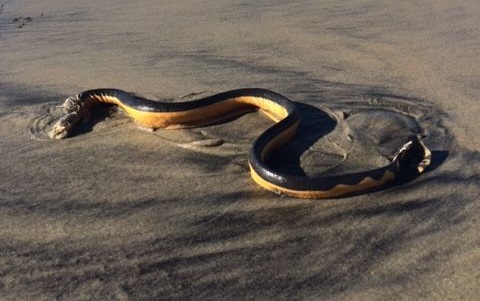On January 12, a 20-inch-long venomous sea snake washed up on the shores of California, marking the third such snake species to wash up on the shores of California in recent months.
The recent sighting was first made by a passerby who notified local lifeguards who in turn secured the snake, which eventually died, before handing it over to the Scripps Institution of Oceanography.
Before the most recent, which washed ashore on Coronado Dog Beach in Southern California, the last two were spotted in 2015 on Bolsa Chica State Beach and Silver Strand Beach– both of which are located in Southern California. Prior to which, the last sighting of a yellow-bellied sea snake above the tip of Baja California took place in 1972, Live Science reported.
A total of six yellow-bellied sea snakes have been reported above Baja California, Mexico, according to assistant curator of herpetology Greg Pauly with the Natural History Museum of Los Angeles.
Scientists believe that the snakes, which pose a small threat to humans, have made their way north again, to non-tropical waters which they rarely inhabit, as a result of El Nino’s warmer waters. And they’re not the only species that has traveled northward with the warming waters caused by the tropical storm, as hammerhead sharks and other species uncommon to the waters off the coast of California have been spotted in recent times.
Biology professor Karen Martin with Pepperdine University in Malibu was quoted by Live Science as having said that “it’s unusual to see the snakes, but not unexpected when you have these really warm waters from the El Niño event”.
In general, we see fish moving north that are unusual in these areas — like hammerhead sharks or mahimahi — and it’s unusual to see the snakes, but not unexpected when you have these really warm waters from the El Niño event
UCLA professor of ecology and evolutionary biology, Paul Barber, told the Huffington Post after the first sea snake was discovered back in October that the snakes have arrived “because the warmer El Niño conditions have expanded the range of suitable environmental conditions for this snake.”
Because the water is so warm here now, these snakes can swim, hunt and reproduce just like they could in the northern part of their tropical range […] Simply put, they are here because the warmer El Niño conditions have expanded the range of suitable environmental conditions for this snake.
While El Nino is believed to play a role in their journey north, what remains unclear to researchers is exactly why the snakes are washing up beaches. According to Martin, it’s “probably” reflective of the stress incurred while away from home and perhaps the travel itself.
























